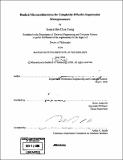Banked microarchitectures for complexity-effective superscalar microprocessors
Author(s)
Tseng, Jessica Hui-Chun, 1977-
DownloadFull printable version (27.81Mb)
Other Contributors
Massachusetts Institute of Technology. Dept. of Electrical Engineering and Computer Science.
Advisor
Krste Asanović.
Terms of use
Metadata
Show full item recordAbstract
High performance superscalar microarchitectures exploit instruction-level parallelism (ILP) to improve processor performance by executing instructions out of program order and by speculating on branch instructions. Monolithic centralized structures with global communications, including issue windows and register files, are used to buffer in-flight instructions and to maintain machine state. These structures scale poorly to greater issue widths and deeper pipelines, as they must support simultaneous global accesses from all active instructions. The lack of scalability is exacerbated in future technologies, which have increasing global interconnect delay and a much greater emphasis on reducing both switching and leakage power. However, these fully orthogonal structures are over-engineered for typical use. Banked microarchitectures that consist of multiple interleaved banks of fewer ported cells can significantly reduce power, area, and latency of these structures. (cont.) Although banked structures exhibit a minor performance penalty, significant reductions in delay and power can potentially be used to increase clock rate and lead to more complexity-effective designs. There are two main contributions in this thesis. First, a speculative control scheme is proposed to simplify the complicated control logic that is involved in managing a less-ported banked register file for high-frequency superscalar processors. Second, the RingScalar architecture, a complexity-effective out-of-order superscalar microarchitecture, based on a ring topology of banked structures, is introduced and evaluated.
Description
Thesis (Ph. D.)--Massachusetts Institute of Technology, Dept. of Electrical Engineering and Computer Science, 2006. Includes bibliographical references (p. 95-99).
Date issued
2006Department
Massachusetts Institute of Technology. Department of Electrical Engineering and Computer SciencePublisher
Massachusetts Institute of Technology
Keywords
Electrical Engineering and Computer Science.